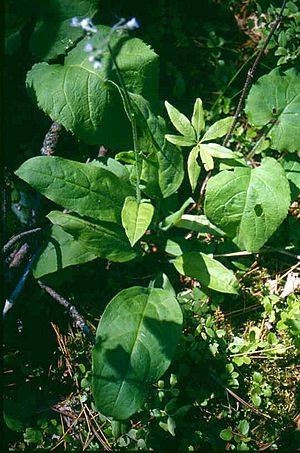Andersonglossum boreale facts for kids
Quick facts for kids Andersonglossum boreale |
|
|---|---|
 |
|
| In Bruce County, Ontario | |
| Scientific classification | |
| Genus: |
Andersonglossum
|
| Species: |
boreale
|
| Synonyms | |
|
|
Andersonglossum boreale, also known as northern wild comfrey, is a type of flowering plant. It belongs to the borage family, called Boraginaceae. This plant naturally grows in the northern parts of North America. You can find it in boreal forests and mixed forests. Its range stretches from Nova Scotia to British Columbia and Yukon in Canada. In the United States, it grows as far south as New Jersey and Indiana. Northern wild comfrey often prefers rocky or sandy soils. Sadly, it has disappeared from many southern areas where it once grew.
What Does Northern Wild Comfrey Look Like?
Northern wild comfrey is a small plant that lives for many years. It can grow up to 2 ft (61 cm) (about 60 cm) tall. The leaves are shaped like ovals. They are wider near the bottom of the plant. These leaves can be 4–8 in (10–20 cm) (10–20 cm) long and 1–3 in (25–76 mm) (2.5–7.5 cm) wide. The lower leaves have short stems, while the upper leaves wrap around the main plant stem.
At the top of the plant, you'll see a group of branches with several small, blue flowers. Each flower has five petals. After the flowers bloom, the plant produces a fruit. This fruit is a small, bristly nutlet.
How Scientists Name Plants
Scientists give plants special names to help identify them. Northern wild comfrey was first named Cynoglossum boreale in 1905. Over time, scientists sometimes change how they classify plants. This happens as they learn more about them.
For a while, some thought this plant was a type of Cynoglossum virginianum. That plant is a similar species found further south. But later, scientists decided it was different enough to be its own species again. They then called it Andersonglossum boreale.
In 2015, a scientist named James I. Cohen tried to give it the name A. boreale. However, the way he did it wasn't quite right according to the rules for naming plants. These rules are in the International Code of Nomenclature for algae, fungi, and plants.
Then, in 2017, the same scientist worked with Pedro Jiménez-Mejías and Robert F. C. Naczi. They did a new study. They carefully compared many plant samples. Their study showed that A. boreale is indeed different from Andersonglossum virginianum. They found that A. boreale has shorter calyxes (the green parts that protect the flower bud). It also has smaller flowers and smaller nutlets. This new study officially confirmed Andersonglossum boreale as its own species.
Images for kids



